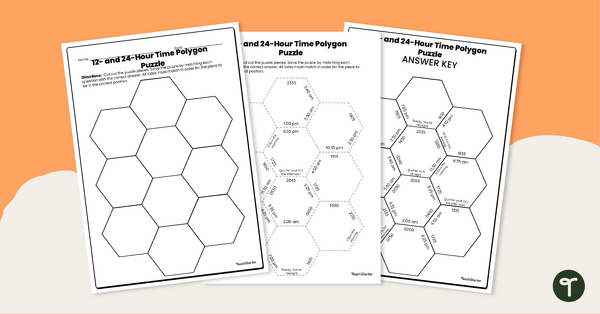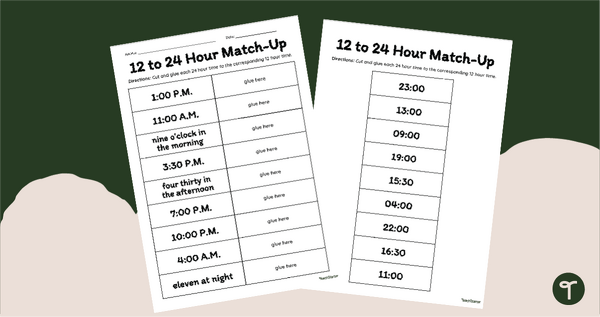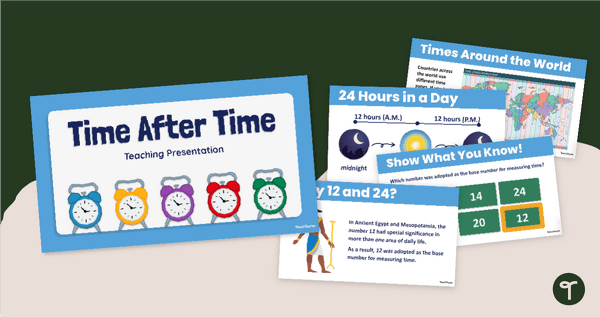24 Hour Time Teaching Resources
Browse 24 hour time worksheets, clock templates and more teacher-created resources to help your students learn how to read and interpret 14 hour time and convert from 12 hour time.
The printable and digital maths resources in this collection are aligned with Australian maths curriculum standards, and you'll find everything you need to build lesson plans that will engage students while building their time-telling skills!
Whether you're teaching year 5 students to solve problems involving time durations, working with a year 4 class on representing time using both the 12-hour and 24-hour clocks or explaining the difference between a.m. and p.m. to year 3 students, there's something for every maths teacher in this collection!
Whether you're teaching about 24 hour time for the first time or just looking for some fresh ideas, we've got you covered! Read on for a primer from our teacher team that covers the difference between 12 hour time and 24 hour time,
What Is 24 Hour Time? A Kid-Friendly Explanation
Are you searching for an easy answer for 'what is 24 hour time' that you can use to explain this maths concept to your students? Here's one from our teacher team that's just for kids:
Also known as international time, 24 hour time is a system that divides the day into 24 hours to track the time of day. In the 24 hour system, the clock runs from midnight to midnight, beginning at 00:00 or 0:00 and ending at 23:59.
24 Hour Time vs. 12 Hour Time — What's the Difference?
Both 24 hour time and 12 hour time are used here in Australia, which makes it important for our students to learn them both and learn to easily convert from one to the other and back again.
But what makes these two time systems different? And when do we use each type? Let's break down the differences between 12 hour and 24 hour time!
24 Hour Time
- Uses numbers 1-23 to denote hours
- Breaks the day into 24 hours
- Uses two digits to denote the hour
- Has the same morning hours as 12 hour time but different afternoon/night hours
- Does not involve the use of a.m. or p.m.
- Is typically used in more formal settings, including hospitals and the military
12 Hour Time
- Uses numbers 1-12 to denote hours
- Breaks the day into 2 segments, each 12 hours long
- Has the same morning hours as 24 hour time but different afternoon/night hours
- Is used in most everyday time-telling situations, such as the time that school opens and closes or the time when important events will occur
- Requires us to use a.m. and p.m.
- Runs from 1 a.m. to noon and then from 1 p.m. to midnight
Teaching How to Write 24 Hour Time
Teaching students how to write 24 hour time builds off of what they've learned about writing 12 hour time. After all, the first 12 hours are similar in both time systems, with the hour written first, followed by a colon and then the minute.
There are, however, some key differences:
- In 24 hour time, the hours are always written as two digits.
- There is no need to add 'a.m.' or 'p.m.' to signify if it's before or afternoon in 24 hour time.
The following format should be used for writing 24 hour time:
2-digit hour:2-digit minute
For example, if the hour is 1 in the morning, and the minute is 39, the time written in the 24 hour time format would be 01:39.
If the seconds are also known, they can be added after the minutes by adding an additional colon and two more digits. For example, 01:39:05.
Here's how each hour of the day is written on the 12 hour clock and on the 24 hour clock:
| 12 Hour Time | 24 Hour Time |
| 1 a.m. | 01:00 |
| 2 a.m. | 02:00 |
| 3 a.m. | 03:00 |
| 4 a.m. | 04:00 |
| 5 a.m. | 05:00 |
| 6 a.m. | 06:00 |
| 7 a.m. | 07:00 |
| 8 a.m. | 08:00 |
| 9 a.m. | 09:00 |
| 10 a.m. | 10:00 |
| 11 a.m. | 11:00 |
| 12 p.m. | 12:00 |
| 1 p.m. | 13:00 |
| 2 p.m. | 14:00 |
| 3 p.m. | 15:00 |
| 4 p.m. | 16:00 |
| 5 p.m. | 17:00 |
| 6 p.m. | 18:00 |
| 7 p.m. | 19:00 |
| 8 p.m. | 20:00 |
| 9 p.m. | 21:00 |
| 10 p.m. | 22:00 |
| 11 p.m. | 23:00 |
Converting 12 Hour Time to 24 Hour Time
For the first 12 hours of the day, no conversion is needed between 12 hour and 24 hour time as they are the same.
However, once the day reaches 1 p.m. or noon on the 12 hour clock, students need to add the number 12 to convert the time of day to the 24 hour time format.
For example, 1 p.m. on the 12 hour clock could be converted to 24 hour time by adding 1+12. The time would then be 13:00.
To convert from the 24 hour clock back to 12 hour time, we subtract 12 hours from any number 13 or higher.
- Free Plan

Telling 24 Hour Time - Clock Worksheet
Download a free Year 5 Telling Time worksheet to practise telling time on a 24-hour clock.
- Plus Plan

12 and 24-Hour Time Puzzle Pops
Build batches of tasty ice lollies with a maths centre to match 12 and 24-hour times.
- Plus Plan

12 and 24 Hour Time Worksheet - Polygon Puzzle
Engage with 12 and 24 hour time with this fun 12 and 24 hour worksheet polygon puzzle.
- Plus Plan

24-Hour Time Sort Worksheet
Match 12 and 24-hour time with a cut and paste time conversion worksheet.
- Plus Plan

24-Hour Time Memory - Year 5 Maths Game
Practise converting 12-hour and 24-hour times with this fun 24-Hour Time Game.
- Plus Plan

12/24 Hour Time Conversions - Practice Sheets
Review how to convert between 12 and 24-hour times with a set of printable Year 5 Maths worksheets.
- Plus Plan

Telling Time in 24 Hour Format Worksheet
Practise converting between 12 and 24-hour clock times with a printable Year 5 time worksheet.
- Plus Plan

Converting 12 to 24 Hour Time Teaching Slides
Teach your students to convert between 12 and 24-hour clock times with an interactive teaching slide presentation.
- Free Plan

24-Hour Time Poster
A poster showing 24-hour time and how it correlates with am/pm.
- Plus Plan

Time After Time Mathematics PowerPoint
Introduce your students to the history of the clock, time zones, and telling time with an interactive teaching presentation.
- Plus Plan

Concepts of Time Assessment - Year 5 and Year 6
Assess your students' knowledge of elapsed time, reading schedules, converting 12 and 24-hour time and reading timelines with a Concepts of Time Test.
- Plus Plan

12- and 24-Hour Clock Template
A template for an interactive 12- and 24-hour clock.
- Plus Plan

Interactive Clock for Teaching Time (Analogue and Digital)
Teach time with an interactive digital clock designed to add a hands-on element to this important primary school lesson!
- Plus Plan

Converting Time
A 60 minute lesson in which students will convert between 12- and 24-hour time systems.
- Plus Plan

12- and 24-Hour Time
A 60 minute lesson in which students will understand the relationship between 12- and 24-hour time systems.
- Plus Plan

Applications of Time Unit Plan - Year 5 and Year 6
This Mathematics unit addresses the concepts of 12- and 24-hour time, timetables and timelines.